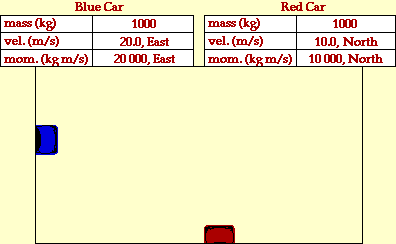Momentum

- The momentum of a particle is defined as the product of its
mass times its
velocity. It is a vector quantity.
 Hewitt's
CP Surf Unit I: Mechanics Unit 1:
Chapter
7 Learning Links Hewitt's
CP Surf Unit I: Mechanics Unit 1:
Chapter
7 Learning Links
Conservation of Momentum
The
momentum of an
isolated
system is a constant. The vector sum of the momenta mv of all the objects of
a system cannot be changed by interactions within the system. This puts a strong
constraint on the types of motions which can occur in an isolated system. If one
part of the system is given a momentum in a given direction, then some other
part or parts of the system must simultaneously be given exactly the same
momentum in the opposite direction. As far as we can tell, conservation of
momentum is an absolute symmetry of nature. That is, we do not know of anything
in nature that violates it.
Impulse of Force
The product of average
force and
the time it is exerted is called the impulse of force. From
Newton's second
law

the impulse of force can be extracted and found to be equal to the change in
momentum of an
object provided the mass is constant:
Elastic Collisions
A perfectly
elastic collision
is defined as one in which there is no loss of
kinetic energy in
the collision.
Simply put, if objects collide without doing permanent
damage, their collision can be described as elastic.
Inelastic Collisions
An
inelastic
collision is one in which part of the kinetic energy is changed to some
other form of energy in the collision. This usually happens by the kinetic
energy being transformed into some other form of energy such as heat and/or by
doing some work, such as smashing a car into a wall. Usually, collisions where
there is permanent damage, or deformation, of one or more of the colliding
objects are considered inelastic.
Note: Any collision between objects will convert some of
the kinetic energy into
internal
energy and other forms of
energy,
so no large scale impacts are perfectly elastic.
Hyperlinks to other sites
|